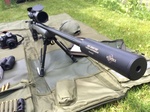Le flip up magnifier version tld
Page 1 sur 1
 Le flip up magnifier version tld
Le flip up magnifier version tld
Bonjour tout le monde
Un drôle d'accessoire qui est intéressant pour le TLD et les records de distance, à noter le châssis cage en alu pour protéger l’optique.
http://www.tacomhq.com/products---charlie.html
To add range, the Charlie TARAC shifts an incoming target image's vertical with precision mirrors to add a specific MIL (milliradians) or MOA (minutes of angle) value to your scope or optic.
MIL and MOA describe bullet drop. The greater the bullet drop due to gravity, greater the range and distance from the target. High-end scopes typically have 30 MILs of adjustment, or this means you can compensate for 30 MILs of bullet drop; however, depending on the distance of the target, this value may be much higher (60, 70, 80+ MILs). In such instances, its customary to attach a specially slanted rail, adjustable height rings, or a mechanical device to physically move the entire scope assembly up or down to provide additional MILs or elevation, but this can be inaccurate or even unrepeatable. It can be especially time consuming, and the wear and tear on the mounting units and hardware are a failure waiting to happen. You can now purchase a custom action with a flat built in rail and never worry about not having enough rail.
The Charlie TARAC compensates for bullet drop (aka bullet drop) automatically by using precision mirrors to shift a target image a set MIL or MOA value. This makes the TARAC is 100% accurate and repeatable for "Why PHYSICALLY change the scope position or mechanics, when all that's necessary is to change the scope's light path?" (Fifty Caliber Shooters Association).
We shift the target image optically before the scope "sees" the image, and this shift will always be the same scope to scope. So if your unit is set to add 80 MILs say for your Schmit Bender, it will also shift 80 MILs on Nightforce, Leupold, Vortex, etc. By shifting the image in front of the targeting device (the optics), there is no impact to the scope physically or mechanically that would require any other adjustments.
Boosting a scope's range is perfect long / sniper rifle enthusiasts, long range hunters, security teams, law enforcement, and military operators.
Un drôle d'accessoire qui est intéressant pour le TLD et les records de distance, à noter le châssis cage en alu pour protéger l’optique.
http://www.tacomhq.com/products---charlie.html
To add range, the Charlie TARAC shifts an incoming target image's vertical with precision mirrors to add a specific MIL (milliradians) or MOA (minutes of angle) value to your scope or optic.
MIL and MOA describe bullet drop. The greater the bullet drop due to gravity, greater the range and distance from the target. High-end scopes typically have 30 MILs of adjustment, or this means you can compensate for 30 MILs of bullet drop; however, depending on the distance of the target, this value may be much higher (60, 70, 80+ MILs). In such instances, its customary to attach a specially slanted rail, adjustable height rings, or a mechanical device to physically move the entire scope assembly up or down to provide additional MILs or elevation, but this can be inaccurate or even unrepeatable. It can be especially time consuming, and the wear and tear on the mounting units and hardware are a failure waiting to happen. You can now purchase a custom action with a flat built in rail and never worry about not having enough rail.
The Charlie TARAC compensates for bullet drop (aka bullet drop) automatically by using precision mirrors to shift a target image a set MIL or MOA value. This makes the TARAC is 100% accurate and repeatable for "Why PHYSICALLY change the scope position or mechanics, when all that's necessary is to change the scope's light path?" (Fifty Caliber Shooters Association).
We shift the target image optically before the scope "sees" the image, and this shift will always be the same scope to scope. So if your unit is set to add 80 MILs say for your Schmit Bender, it will also shift 80 MILs on Nightforce, Leupold, Vortex, etc. By shifting the image in front of the targeting device (the optics), there is no impact to the scope physically or mechanically that would require any other adjustments.
Boosting a scope's range is perfect long / sniper rifle enthusiasts, long range hunters, security teams, law enforcement, and military operators.

Fanfoue74- Modérateur

- Nombre de messages : 321
Age : 41
Localisation : Haute Savoie
Date d'inscription : 10/07/2015
 Sujets similaires
Sujets similaires» Turrets Elevation Magnifier
» Lunette ou point rouge + magnifier
» lens flip cover pour Schmidt&Bender 5-25x56 TENEBREAX
» Big 3 East Spike’s New .416 Spike – a .308 version of .300
» Forum version web sur téléphone
» Lunette ou point rouge + magnifier
» lens flip cover pour Schmidt&Bender 5-25x56 TENEBREAX
» Big 3 East Spike’s New .416 Spike – a .308 version of .300
» Forum version web sur téléphone
Page 1 sur 1
Permission de ce forum:
Vous ne pouvez pas répondre aux sujets dans ce forum











» Chassis Sabatti TLD
» Détente Sabatti
» quel grossissement??
» Norma Xtreme 22Lr
» Recherche Stand TLD dans le 35 ou le 22
» LUNETTES LYMAN Super-Targetspot et UNERTL Toute une époque!
» Choix lunette
» Règlement TLD ?
» Recherche information kit caméra
» CZ SDS 457
» rds explosé